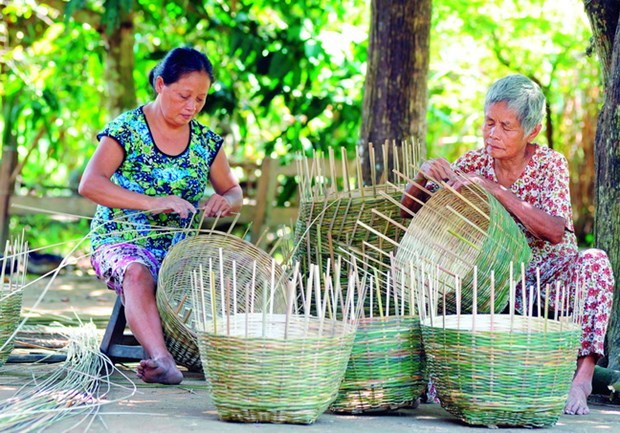 Society
Society

The lives of the Khmer people in Trà Vinh have improved significantly since the province began to prioritise investment in infrastructure and support policies for them in recent years.

|
| Artisans make baskets in a bamboo handicraft village in Trà Vinh Province’s Trà Cú District. — VNA/VNS Photo Phúc Thanh |
TRÀ VINH — The lives of the Khmer people in Trà Vinh have improved significantly since the province began to prioritise investment in infrastructure and support policies for them in recent years.
The Cửu Long (Mekong) Delta province has more than 300,000 Khmer, or nearly 32 per cent of its population and the second largest number in the delta after Sóc Trăng.
In Khmer-dominated areas, the province has given priority to creating infrastructure, including rural roads to enable them to travel and transport agricultural produce.
In Cầu Kè District’s Châu Điền Commune, 80 per cent of the 409 households in Trà Bơn Hamlet are Khmer, and all roads there are paved under the national target programme on building new-style rural areas.
Sơn Đường, secretary of the Trà Bôn Party Cell, said the hamlet has built five roads, dredged and upgraded 12 in-field irrigation canals and built 14 concrete bridges since 2015.
“The appearance of the hamlet has been improved significantly.”
Local Khmer households actively participate in the programme and have even donated more than 3.5ha land for building roads since 2015, he said.
Phạm Minh Truyền, director of the department, said the province has mobilised more than VNĐ5.7 trillion (US$250 million) to implement the national target programme on building new-style rural areas in 2016 -20.
Now 72 of the province’s 85 communes meet all 19 criteria for new-style rural areas set under the national programme. They are related to planning, infrastructure, transport, irrigation, electricity, income, education, healthcare, environment, social security, culture, and others.
The province targets all communes to be in full compliance by 2025.
Support
Trà Vinh has effectively implemented poverty reduction models to help poor Khmer people do agriculture or business and reduce poverty in recent years.
Trà Cú District, where more than 62 per cent of the population are Khmer, for instance, has adopted a model in Đại An Commune’s Giồng Lớn A Hamlet under which, in unproductive monoculture rice fields, rice and taro or corn are rotated.
Taro offers farmers an income of VNĐ150 – 200 million ($6,600 – 8,700) per hectare per crop of around four months, and because of the high income, many farmers have opted for taro.
The average annual income of people in Giồng Lớn A has increased to VNĐ48 million ($2,100) per person now, an increase of VNĐ30 million ($1,300) from 2012.
The hamlet has only eight poor households now, 200 fewer than in 2012.
Besides helping local households restructure agriculture, local authorities have also supported the district’s three handicraft villages to develop production to create more jobs, especially for Khmer people.
The villages, which produce household utensils from bamboo and sedge, provide jobs for 3,000 labourers with an average monthly income of VNĐ2.5 – 6 million ($110 - 260).
Trì Cảnh Establishment, which makes tables, chairs and other household utensils from bamboo in Hàm Giang Commune’s bamboo handicraft village, has its table-chair set recognised as a four-star OCOP product under the national ‘one commune – one products’ (OCOP) programme.
The set includes a table, two chairs and a bench.
Local authorities are helping the establishment register for increasing the rating to five star, the programme’s highest level.
Dương Văn Triệu, secretary of the Trà Cú District Party Committee, said with the implementation of synchronous poverty reduction measures, the lives of people have improved significantly and the poverty rate is being reduced year after year.
More than 700 poor households escaped poverty last year and the district targets a further 863 poor households this year, he said.
The province’s support to poor Khmer people in the form of soft loans and other financial assistance, and free vocational training have helped many escape poverty and achieve stable lives.
Farmer Thạch Hoài Phong in Cầu Ngang District’s Thuận Hoà Commune used to be poor before he was given two soft loans for building a house and growing vegetables on his 5,000sq.m farm.
With the VNĐ25 million ($1,100) loan for farming, he has escaped poverty after a few years of growing vegetables, he said.
Besides, he now has a rice combine harvester that he hires out to earn VNĐ50 million ($2,200) during each rice crop, he said.
The province People’s Committee has instructed the Department of Agriculture and Rural Development to strengthen support to farmers, especially Khmer, for restructuring their farming to increase incomes.
The province hopes to achieve annual average output of VNĐ145 million ($6,400) per hectare of crops and VNĐ380 million ($16,700) per hectare of aquaculture by 2025, up VNĐ 15 – 20 million ($660 - 880) from this year.
For this, it will prioritise use of funds from the Government to support ethnic households while using its own resources to build infrastructure.
It will develop farming models that use advanced techniques and offer high incomes, and train Khmer farmers in them to help increase their incomes. — VNS